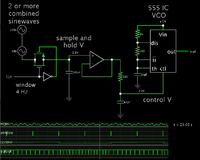FlorianB
Newbie level 4

- Joined
- Dec 30, 2013
- Messages
- 7
- Helped
- 0
- Reputation
- 0
- Reaction score
- 0
- Trophy points
- 1
- Location
- Santa Monica, CA
- Activity points
- 88
How to make a Worldclock generator with randomly altered frequency around 96KHz?
Hi!
For a very specific project of mine I would need to create a hardware worldclock generator (BNC).
The frequency would be around 96KHz, and very stable from one impulse to the next, but the frequency itself would vary "randomly" around 96KHz at a 100-500ms rate.
I would have 3 buttons:
- amplitude of variation (e.g. 1% would allow the frequency to vary from 95.04 to 96.96)
- average speed of variation
- amplitude of speed
But these 3 are still pretty "random".
We can basically summarize this project as a "tape pitch" simulator for soundcards / audio DA converters.
Anyone knows where I could start my research?
THANKS!
Hi!
For a very specific project of mine I would need to create a hardware worldclock generator (BNC).
The frequency would be around 96KHz, and very stable from one impulse to the next, but the frequency itself would vary "randomly" around 96KHz at a 100-500ms rate.
I would have 3 buttons:
- amplitude of variation (e.g. 1% would allow the frequency to vary from 95.04 to 96.96)
- average speed of variation
- amplitude of speed
But these 3 are still pretty "random".
We can basically summarize this project as a "tape pitch" simulator for soundcards / audio DA converters.
Anyone knows where I could start my research?
THANKS!

